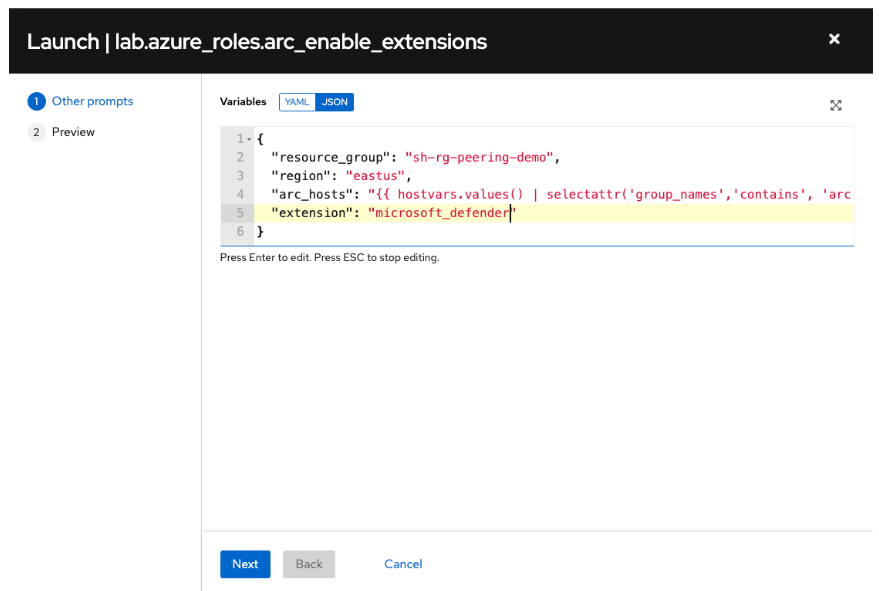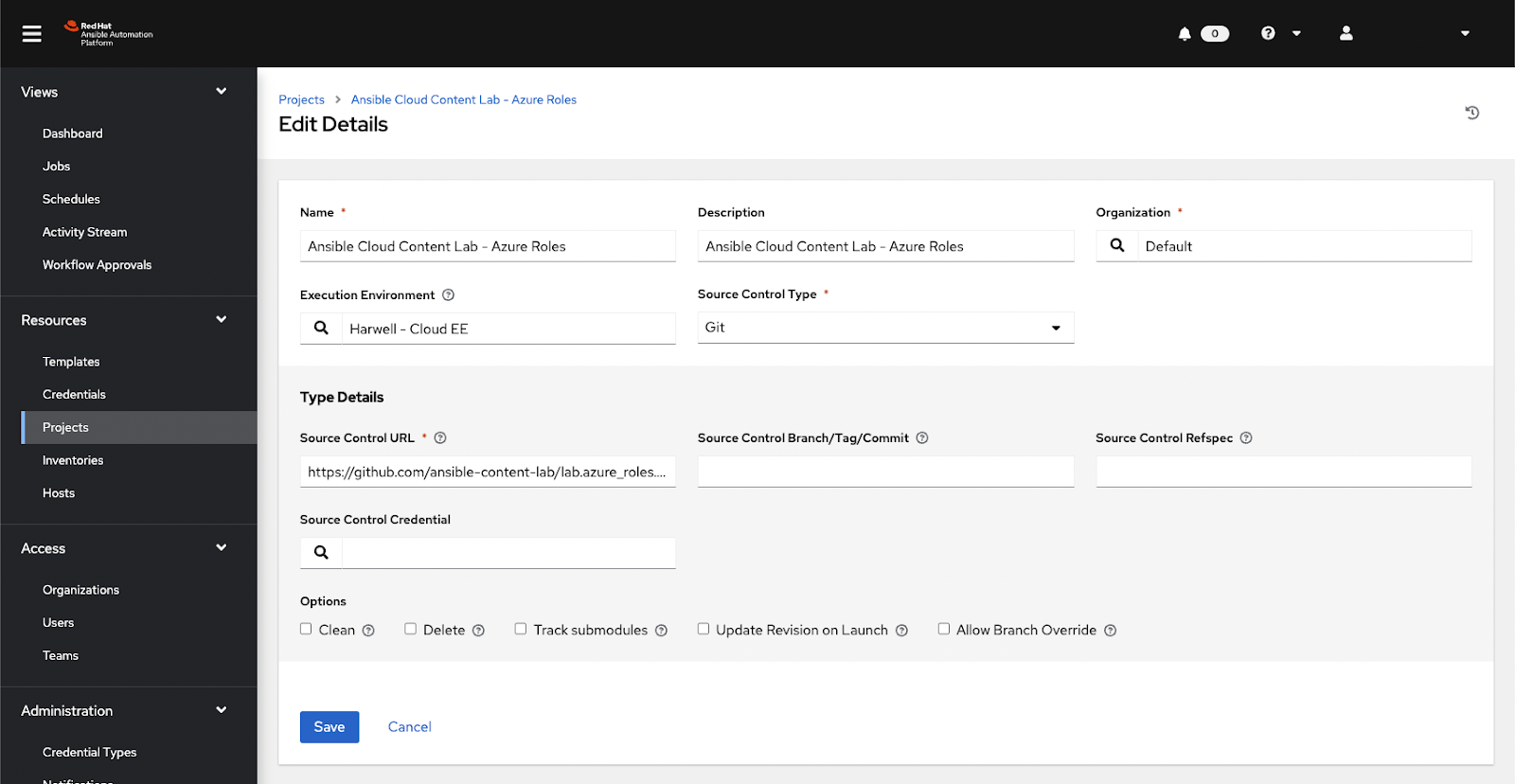Enable Azure VM extensions by using Red Hat Ansible automation
This article shows you how to deploy virtual machine (VM) extensions to Azure Arc-enabled servers at scale by using Red Hat Ansible Automation Platform. The examples in this article rely on content developed and incubated by Red Hat through the Ansible Content Lab for Cloud Content.
This article also uses the Azure Infrastructure Configuration Demo collection. This collection contains many roles and playbooks that are pertinent to this article, including the following:
| File or folder | Description |
|---|---|
| playbook_enable_arc_extension.yml | Playbook that's used as a job template to enable Azure Arc extensions. |
| playbook_disable_arc-extension.yml | Playbook that's used as a job template to disable Azure Arc extensions. |
| roles/arc | Ansible role that contains the reusable automation that the playbooks use. |
Note
The examples in this article target Linux hosts.
Prerequisites
Automation Controller 2.x
This article is applicable to both self-managed Ansible Automation Platform and Red Hat Ansible Automation Platform on Microsoft Azure.
Automation execution environment
To use the examples in this article, you need an automation execution environment with both the Azure collection and the Azure CLI installed. Both are required to run the automation.
If you don't have an automation execution environment that meets these requirements, you can use this example.
For more information about building and configuring automation execution environments, see the Red Hat Ansible documentation.
Azure Resource Manager credential
A working account credential configured in Ansible Automation Platform for Azure Resource Manager is required. Ansible Automation Platform uses this credential to authenticate operations by using the Azure collection and the Azure CLI.
Configure the content
To use the Azure Infrastructure Configuration Demo collection in Automation Controller, follow these steps to set up a project with the repository:
Log in to Automation Controller.
On the left menu, select Projects.
Select Add, and then complete the fields of the form as follows:
Name: Enter Content Lab - Azure Infrastructure Configuration Collection.
Execution Environment: Select with the Azure collection and Azure CLI instead.
Source Control Type: Select Git.
Source Control URL: Enter
https://github.com/ansible-content-lab/azure.infrastructure_config_demos.git.
Select Save.
After you save the details, the project should be synchronized with Automation Controller.
Create job templates
The project that you created from the Azure Infrastructure Configuration Demo collection contains example playbooks that implement the reusable content in roles. You can learn more about the individual roles in the collection by viewing the README file included with the collection.
The following mapping within the collection can help you identify which extension you want to enable.
| Extension | Extension variable name |
|---|---|
| Microsoft Defender for Cloud integrated vulnerability scanner | microsoft_defender |
| Custom Script Extension | custom_script |
| Azure Monitor for VMs (insights) | azure_monitor_for-vms |
| Azure Key Vault virtual machine extension | azure_key_vault |
| Azure Monitor agent | azure_monitor_agent |
| Azure Automation Hybrid Runbook Worker extension | azure_hybrid_rubook |
You need to create templates so that you can enable and disable Azure Arc-enabled server VM extensions, as described in the following sections.
Note
There are additional VM extensions not included in this collection. They're outlined in Virtual machine extension management with Azure Arc-enabled servers.
Enable Azure Arc VM extensions
This template is responsible for enabling an Azure Arc-enabled server VM extension on the hosts that you identify.
Important
Azure Arc supports enabling or disabling only a single extension at a time, so this process can take some time. If you try to enable or disable another VM extension with this template before Azure completes this process, the template reports an error.
After the job template runs, it might take minutes to hours for each machine to report that the extension is operational. When the extension is operational, you can run this job template again with another extension without getting an error.
To create the template:
On the right menu, select Templates.
Select Add.
Select Add job template, and then complete the fields of the form as follows:
Name: Enter Content Lab - Enable Arc Extension.
Job Type: Select Run.
Inventory: Enter localhost.
Project: Enter Content Lab - Azure Infrastructure Configuration Collection.
Playbook: Enter
playbook_enable_arc-extension.yml.Credentials: Enter your Azure Resource Manager credential.
Variables: Enter the following code:
--- resource_group: <your_resource_group> region: <your_region> arc_hosts: <first_arc_host> <second_arc_host> extension: microsoft_defenderNote
Change
<your_resource_group>,<your_region>,<first_arc_host>, and<second_arc_host>to match the names of your Azure resources. If you have a large number of Azure Arc hosts, use Jinja2 formatting to extract the list from your inventory sources.
Select the Prompt on launch checkbox for variables so that you can change the extension at runtime.
Select Save.
Disable Azure Arc VM extensions
This template is responsible for disabling an Azure Arc-enabled server VM extension on the hosts that you identify. To create the template:
On the right menu, select Templates.
Select Add.
Select Add job template, and then complete the fields of the form as follows:
Name: Enter Content Lab - Disable Arc Extension.
Job Type: Select Run.
Inventory: Enter localhost.
Project: Enter Content Lab - Azure Infrastructure Configuration Collection.
Playbook: Enter
playbook_disable_arc-extension.yml.Credentials: Enter your Azure Resource Manager credential.
Variables: Enter the following code:
--- resource_group: <your_resource_group> region: <your_region> arc_hosts: <first_arc_host> <second_arc_host> extension: microsoft_defenderNote
Change
<your_resource_group>,<your_region>,<first_arc_host>, and<second_arc_host>to match the names of your Azure resources. If you have a large number of Azure Arc hosts, use Jinja2 formatting to extract the list from your inventory sources.
Select the Prompt on launch checkbox for variables so that you can change the extension at runtime.
Select Save.
Run the automation
Now that you have the job templates created, you can enable or disable Azure Arc extensions by simply changing the name of the extension variable. Azure Arc extensions are mapped in the arc role in this file.
When you select the launch 🚀 icon, the template asks you to confirm that the variables are accurate. For example, to enable the Microsoft Defender extension, ensure that the extension variable is set to microsoft_defender. Then, select Next > Launch to run the template.

If no errors are reported, the extension is enabled and active on the applicable servers after a short period of time. You can then proceed to enable (or disable) other extensions by changing the extension variable in the template.
Related content
- You can deploy, manage, and remove VM extensions by using Azure PowerShell, the Azure portal, or the Azure CLI.
- You can find troubleshooting information in the guide for troubleshooting VM extensions.
